The History of Mani and the Maniates – the Fiercest and Most Ruthless People of Greece
 for Trekearth.jpg)
Towers of Vatheia – Mani- Peloponnese – photo – Copyright Phil Simmonds (philsim) for Trekearth
Mani, located on the Peloponnese Peninsula, which was known in The Middle ages and Ottoman era as Morea, was one of the most inaccessible, wildest and mutinous parts of Greece, which, until the 1970s, could only be reached by boat.
Mani is divided into three regions, Outer Mani (North West), Inner, or Deep Mani (South West), and Lower Mani (East).
Inner Mani, with its rugged coastline, is the most authentic region of Mani and starts at the capital city of Mani, Areopolis, which in Greek means ‘City of War’.
It’s no surprise then, that originating from a ‘City of War’, the inhabitants of Mani, the Maniots, more commonly known in Greece as Maniates, have the reputation of being the fiercest people of Greece.

Peloponnese Greece
History of Mani
The Maniates, fierce warriors, said to be descendants of the ancient Dorians and direct descendants of the ancient Spartans, are also said to be some of the most vicious and ruthless of Greeks, known for piracy and vendettas but above all, Maniates are known for their Independence.
Mani was the only region of Greece, which retained self-rule, when Greece fell under Ottoman rule in 1460.
As Ottoman power began to decline, four hundred years later, in the early 1800s, Mani became a stronghold for the Klephts (mountain bandits).
Petros Mavromichalis, ‘chief in charge’ of Mani, leader of The Greek War of Independence, proclaimed the revolution on March 17 1821 at Areopolis.
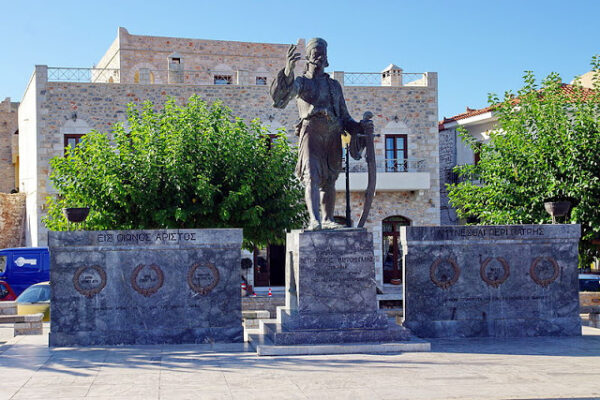
A monument of Petros Mavromichalis in Areopoli – Mani – Peloponnese – photo Bgabel at wikivoyage
Mavromichalis and his heroic Palikaria, played a major role in gaining victory over the Turks in the revolution, resulting in Greece becoming independent, the First Hellenic Republic, governed by Ioannis Kapodistrias.
Greek independence meant Mani losing its local autonomy, which did not go down well with the Maniates.
Mavromichalis and Governor of Greece, Kapodistrias, were forever at loggerheads, at the first opportunity, which happened to be the refusal of Mavromichalis to pay his taxes, Kapoditrias had him thrown in prison.

Ioannis Kapodistrias first governer of Independent Greece, The First Hellenic Republic
This was a major affront to the proud Mavromichalis family, leaders of the successful uprising against the Turks and on 27 September 1831, they took their revenge.
As Kapodistrias was about to attend a ceremony, at the church of Saint Spyridon, in Nafplion, (the capital of the Greek state in the years 1828 – 1833), Mavromichalis’s brother, Konstantis, along with his son Georgos, assassinated Ioannis Kapodistrias, the founder of modern Greece, on the church steps.
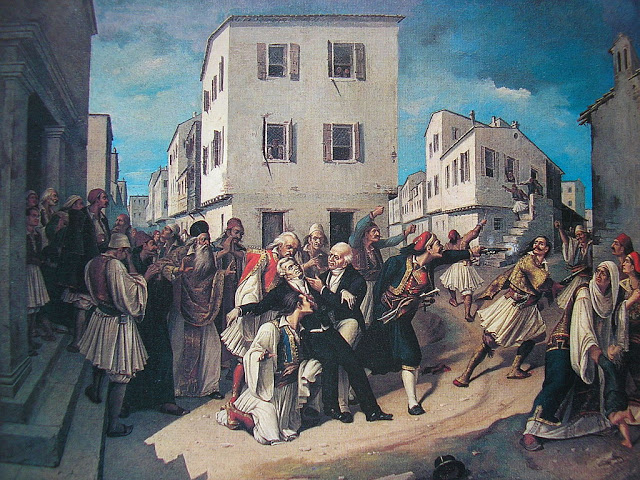
The murder of Kapodistrias by Charalambos Pachis 1844 1891
The assassination of Kapodistrias was the beginning of the end for Mani.
In 1878 the Greek government pulled the plug on Mani’s local autonomy; the place became a backwater, people abandoned the dry, infertile land to find a better life elsewhere.
Many settled in major Greek cities, others tried their luck further afield, in Europe and America.
Quite a number of Maniates fled to Corsica, where their ancestors had settled, during the second half of the seventeenth century, not only due to the lack of arable land but to avoid paying taxes to the Turks during the Ottoman rule)and founded the town of Cargese.
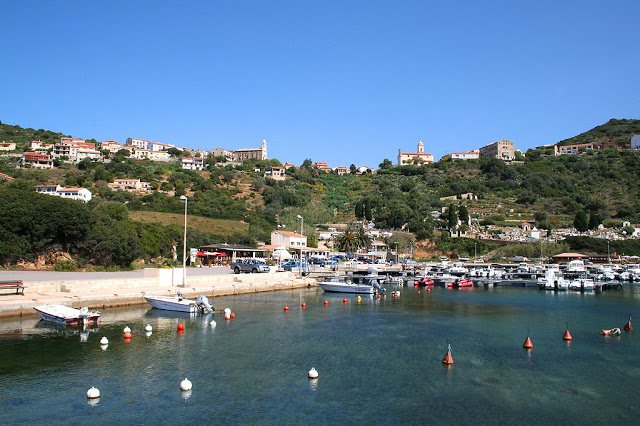
The village and the harbour of Cargese – Corsica – photo Jean-Pol GRANDMONT
The town of Vatheia, scene of so many family feuds and vendettas, with its isolated, fortified towers, became a ruin, and is now one of the most photographed places in Greece
The Maniates who stayed, scratched a living from the dry, rocky, infertile earth, concentrating on the Koroneiki olives, which produce the best virgin olive oil in Greece, and herbs such as oregano, thyme and mint, about the only things to grow in this unforgiving ground.
Piracy was still rife, the Maniates considered it legitimate, their compensation, so to speak, for the infertile land of Mani and lack of natural resources.
Local priests actually blessed the boats before pirates set off on a mission!
After the 1970s, when roads were constructed and Mani was no longer only accessible by sea, the region, although wild and remote, began to prosper.
Small fishing villages, Byzantine churches, sandy beaches and of course, the abandoned towers of Vatheia, became popular tourist attractions, cafes, tavernas and souvenir shops, sprung up by the dozen, to cater to the crowds.
Top 10 Must See Attractions of Mani
1. Kardamyli
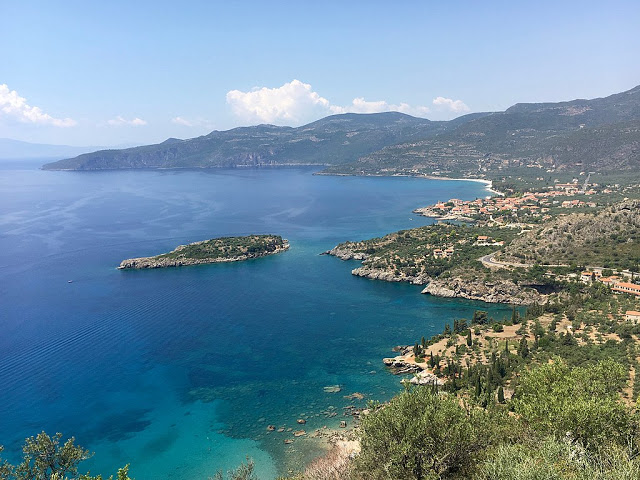
View of Kardamyli and surrounding areas – Mani – Peloponnese
Kardamyli, one of the oldest settlements of The Peloponnese, well known for its many beaches, consists of Upper Kardamyli, the old town, where the buildings are mostly Venetian; here you can see a medieval castle, and the beautiful church of St. Spyridon.
Lower Kardamyli is the newer part of town.
Nearby to Kardamyli is the village of Kalamitsi, home, for many years, to English author Patrick Leigh Fermor, who was made an honorary citizen, for his part in the Greek Resistance, during WWII.
2. Stoupa
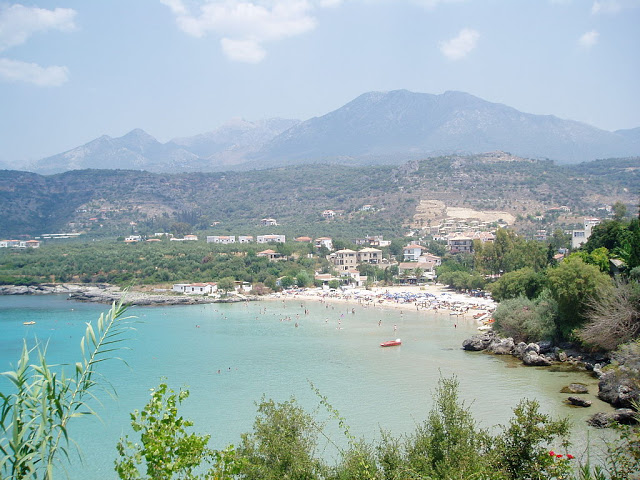
Kalogria, a beach just outside Stoupa – Photo Paul Panagiotidis
Stoupa is a fishing village with many beaches, Stoupa Beach being the most popular, where, at the far end, is a snorkeling site, suitable for beginners.
Another popular beach is Kalogria Beach, with lots of bars and restaurants, about a hundred meters offshore, is an underground sea spring, visible as a disturbance on the surface of the sea.
3. Gytheio

Gytheio; the largest and most important port of the Mani.
Gytheio, is said to have been founded in ancient times, by the Greek Gods, Hercules and Apollo.
The port, which opened in the 1960s, is the largest and most important of the Mani, ancient ruins are submerged in the sea, but some remains of ancient walls can be seen.
On the sandy beach of Valtaki, is the wreck of the Demitrios, a ship owned by the Matsinos brothers, said to have been used for smuggling cigarettes between Turkey and Italy, which ran ashore in 1981 and was then set fire to, to destroy evidence.

The Dimitrios shipwreck on Valtaki beach, near Gythio. Photo – Tsdinos
4. Areopolis

Areopolis – Mani- Peloponnese – Greece
Areopolis, ‘City of War’, named for the Greek God of War, Ares, is the capital city of Mani, located above the bay of Itylo (Oitylo).
Areopolis is the birthplace of the Greek Revolution, Petros Mavromichalis declared war on the Ottomans there on March 17 1821, the town square, ‘Platia Athanatos’, bears his statue.
Although Areopolis is the capital of Mani, it’s a small town, with less than a thousand inhabitants.
5. Limeni
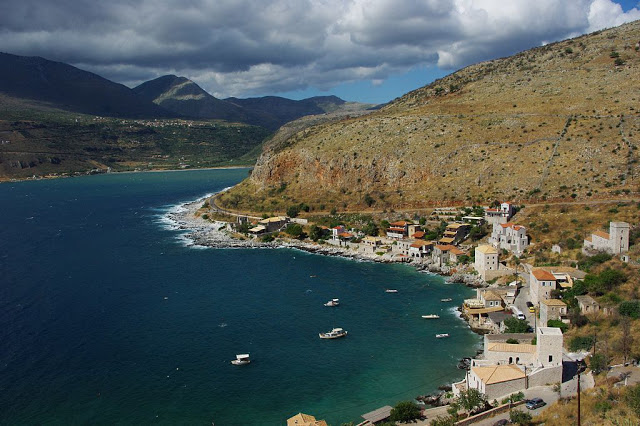
Limeni-Bay – Mani Peninsula, Peloponnese, Greece – foreground is Limeni, port of Areopoli, in the background Itylo- Photo Koppi2
Limeni, a beautiful coastal village, is the small port of Areopolis, which is five kilometers away.
There are no beaches but steps do lead down to the sea, so you can swim in the crystal clear waters.
Limeni was home to the Mavromichalis family, of Greek Revolution fame, the family mansion is located here.
6. Gerolimenas

Gerolimenas – Mani – Peloponnese
Gerolimenas, meaning ‘Old Harbour’, in Greek, is a scenic fishing village, one of the remotest settlements of The Peloponnese, until the 1970s, only reachable by boat.
Gerolmenas was known to export quail to France in the 1870s.
In the past, Gerolimenas, boasted a shipyard, a large fish market, and an ice suppliers, the main industry was fishing, today, it is tourism.
7. Mezapos
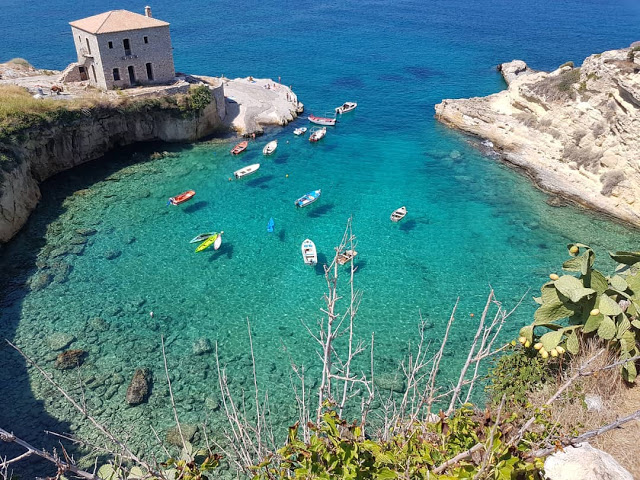
Mezapos – Mani – Peloponnese – photo courtesy od Deskgram
Mezapos, a small fishing cove, is not well-known; it’s a little piece of secret Greece, with two amazing, white-pebble beaches, Chalikia and Alonaki.
In summer, local fishermen will take you across to Cape Tigani, in Greek, ‘frying pan rock’, a flat rock, in the shape of a frying pan, where there are ruins of a castle, said to be an ancient fortress, some say a Frankish castle, some say it’s older.
The trip takes about fifteen minutes.
8. Diros Caves
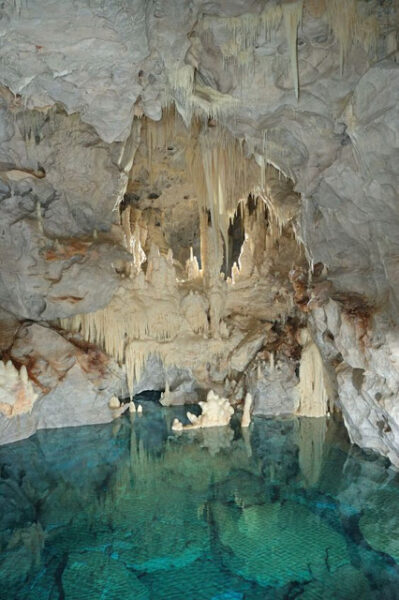
Diros Caves Mani -Peloponnese – Photo submitted to Pixdaus by Danis51
Over five thousand meters of underground caves, said to have been inhabited since Neolithic times, located between Pirgos Diros and Areopolis.
The Diros caves have been continuously explored by geologist and archaeologists since 1949.
A guided tour, thirty minutes by boat, and ten on foot, is a must!
9. Vatheia – Ghost town
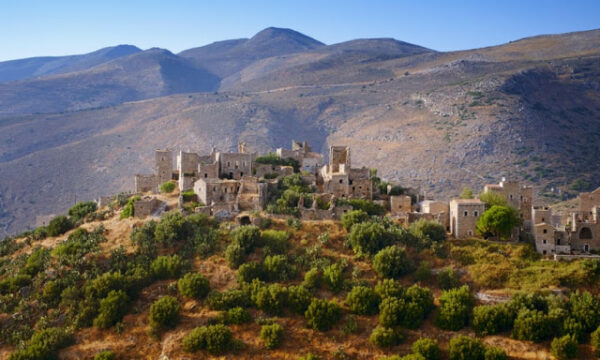
Vathia abandoned village of Mani- Peloponnese – Photo Alamy
Vatheia, the ‘ghost town’, of Mani, is said to be one of the most photographed, and most creepiest places of Greece.
The abandoned stone towers, perched high above the sea, many dating back to the eighteenth century, were built on high ground to protect the notorious feuding families of Mani, from one another!
The view from Vatheia is amazing, and you can stroll around the spooky, deserted houses, entrance is free.
10. Cape Tenaro, or, Cape Matapan
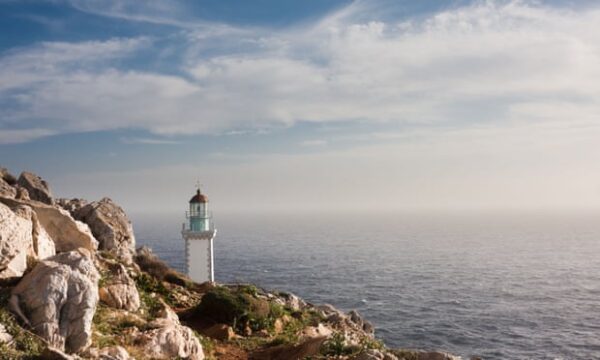
Cape Tenaro lighthouse – Mani – Peloponnese -Greece- Photo Almay
Cape Tenaro separates the Aegean Sea from the Ionian Sea and in ancient times, is said to have a hidden entrance to Hades, the Greek underworld, through which Hercules took the three-headed dog, Cerberus, in one of his twelve labours.
Cape Tenaro is the southernmost point of mainland Greece, directly opposite lies Libya.
The Maniates
Way down in the Deep Mani, the Manites are still some of the most superstitious Greek people, believing in witches, vampires, demons and ghosts, they are also some of the most hospitable people of Greece.
The family feuds and vendettas, which can go on for months, if not years, are still going strong, although they do declare a truce for religious ceremonies and the olive harvest, once they are over, it all fires up again.
One of the last recorded vendettas, against a Cretan, was so ferocious that the Greek police, army and navy had to combine forces and intervene.
The only time the Maniates have been united was against the Turks!
Apart from their strong, independent character how do you know if someone is a Maniatis?
The surnames of Maniates end in ‘akos’ in the inner or deep, southwestern and eastern part of Mani.
Guess what? I’m married to one, MGG – My Greek God‘s family, originates from the Deep Mani!
Related Post:
26 Top Must See Archaeological Sites and Landmarks of Greece



